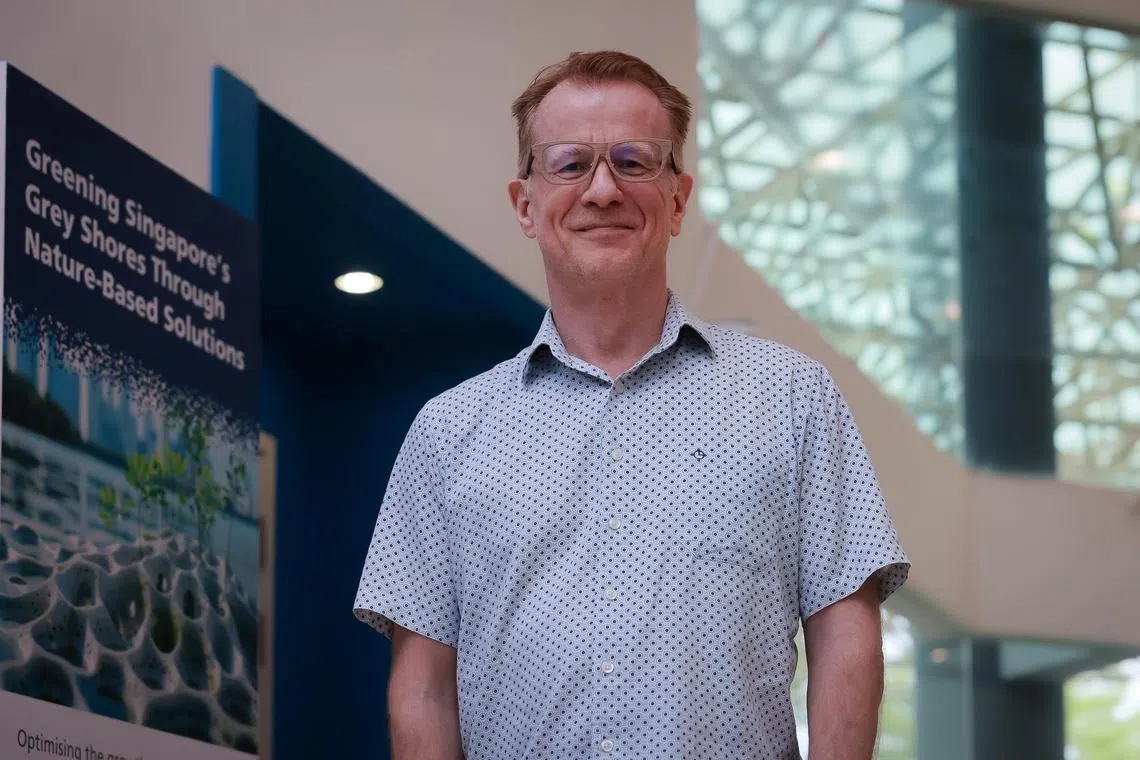NUS coastal protection institute develops talent pipeline, kicks off 17 research projects
Sign up now: Get ST's newsletters delivered to your inbox

Professor Adrian Law, executive director of CFI Singapore, shaking hands with Ms Hazel Khoo, coastal protection department director in PUB, at a signing ceremony with five industry partners.
ST PHOTO: GAVIN FOO
Follow topic:
SINGAPORE - Wanting to be in a role that would contribute viable climate solutions for Singapore, geotechnical engineer Ryan Lee decided to leave his consulting job to help bolster the Republic’s coastal defences to protect against sea-level rise.
Mr Lee, 27, is now a research engineer at the Coastal Protection and Flood Resilience Institute (CFI) at the National University of Singapore (NUS), where he and his team are looking to retrofit existing coastal protection structures around Singapore, making them impervious, to reduce seawater seepage.
He is part of a growing team of 80 researchers, PhD students and principal investigators at the institute, which was launched in 2023 to develop talent capability in coastal protection and flood management efforts, and facilitate research and development in these areas.
Coastal protection structures, ranging from concrete seawalls to sloping rock structures, or rock revetments, currently protect around 74 per cent of Singapore’s coastline.
Scientists expect that sea levels in Singapore could rise by up to 1.15m by the end of the century, depending on how well countries around the world are able to mitigate their greenhouse gas emissions. In the event of extreme weather events such as high tides and storm surges, these levels could spike by a further 4m or 5m.
As many of Singapore’s coastal protection structures were designed to protect mainly against flooding, they may not be adequate for dealing with the looming threat of sea-level rise, said the project leader, Assistant Professor Chew Soon Hoe from NUS’ Department of Civil and Environmental Engineering.
As the extent of sea-level rise can be unpredictable but its onset is slow, a more flexible approach would be to build modular units that can be gradually built up and expanded horizontally, said Prof Chew.
“We don’t want to build a sea wall too high, as this may obstruct some views (if there are housing estates behind the wall),” he added.
Retrofitting existing coastal protection structures with these modular units where possible is also more sustainable and cost-effective than demolishing and rebuilding them, said Prof Chew.
He was speaking to reporters at CFI Singapore’s inaugural symposium, Shaping Coastal and Flood Resilience through Progress and Partnership, held at NUS on Sept 26. The institute is part of a $125 million research programme
With his expertise in geotechnical engineering, which involves work with underground structures such as the North-South Corridor, Mr Lee sees a lot of synergies between his skills and the field of coastal protection.
Just as underground tunnels are supposed to be impervious and resistant to water leakage, the same principles also apply to coastal protection structures, he said.
“I’m glad to be part of a team that will help design and construct a solution that would benefit the younger generation, and collaborate with people from different fields, such as marine biologists and hydrologists,” he added.
Beginning in February, the research team has been working with their industry partners, infrastructure consultancies Surbana Jurong and CPG, to survey existing engineered structures around Singapore.
The project is one of 17 at CFI Singapore, covering areas ranging from developing flexible sea walls to storm surge and wave models.
On Sept 26, CFI Singapore also signed agreements with five companies to promote joint research and development and ensure that the various solutions, and findings, can be translated to real-world applications.
Areas of cooperation include coastal science research, integrating nature-based solutions and building sustainable infrastructure for coastal protection and flood management.
The five companies are construction firm Chip Eng Seng, infrastructural consultancy CPG, geo-data specialist Fugro, construction company Kajima and IT consultant Integral Omni Inspire.
Another project, led by Associate Professor Peter Todd from the Department of Biological Sciences at NUS Faculty of Science, looks at optimising the growth of coastal species, such as mangroves, seagrasses and corals, and improving their survivability within hybrid coastal protection structures.
Integrating nature with hard engineering structures for coastal protection helps to harness nature’s ability to guard against sea-level rise, and ensures that biodiversity ecosystems are able to thrive, while maintaining good water quality.
For example, the research team found that corals growing on submerged breakwaters can help to reduce wave energy, which causes coastal erosion, based on preliminary lab studies.
“We initially worked with 3D-printed corals, but are hoping to do further tests with living corals to validate these results,” said Prof Todd.

Associate Professor Peter Todd leads a project that looks at optimising the growth of coastal species such as mangroves, seagrasses and corals.
ST PHOTO: GAVIN FOO
Different types of manmade mangrove pods, made from concrete blocks and wood pallets, were also tested. These are hard structures surrounding mangrove seedlings that essentially help to strengthen the resilience of these coastal guardians. Mangroves have a natural ability to keep pace with sea-level rise by trapping sediments in their roots, thus preventing coastal erosion.
Given the importance of ensuring that coastal protection solutions have minimal impact on the environment, the research team has been studying the possibility of using green concrete for their hybrid structures, and were able to show that these can still be colonised by living organisms, and are hence suitable for coastal construction, noted Prof Todd.
Green concrete looks to replace the carbon-intensive cement with eco-friendlier alternatives, such as marine clay and processed incineration waste, which can help to reduce the carbon footprint of the construction process.


